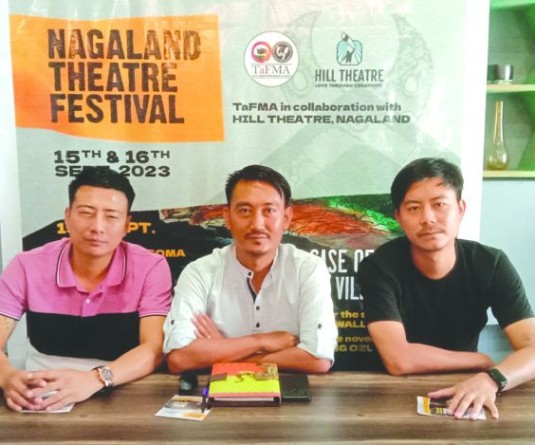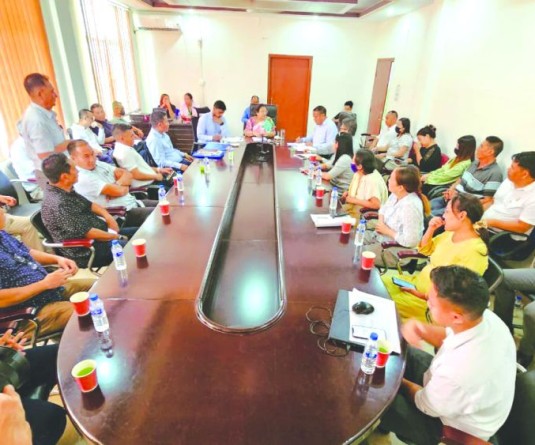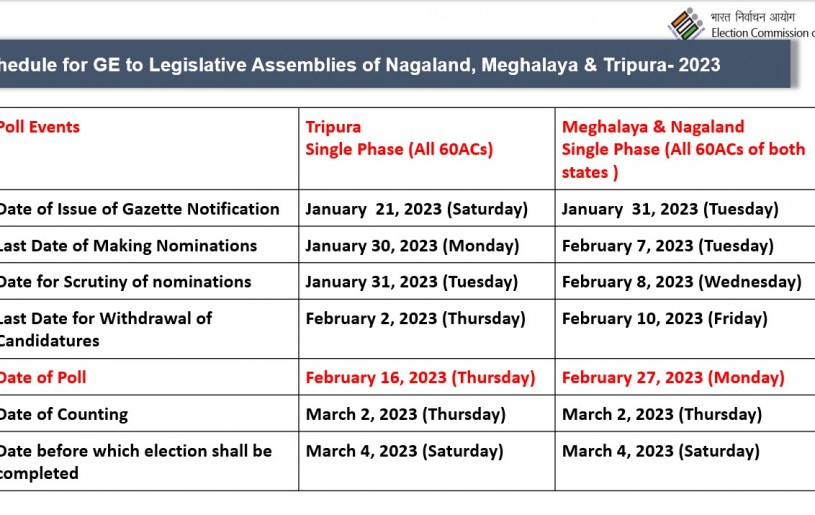Hornbill Festival @ 20: Indigenous or romanticized?

A cultural troupe performs a traditional dance during the 14th edition of the Hornbill Festival at Kisama. (Morung File Photo)
Atono Tsükrü Kense
Kohima | November 30
Ever since the commencement of the Nagaland Hornbill Festival in the year 2000 to celebrate and showcase the rich cultural heritage and traditions of the Nagas and also to promote tourism in the seemingly tiny state of Nagaland, the festival has gained popularity and attracted the attention of tourists from all over the world.
The ten days of vibrant cultural carnival in the Kisama Naga Heritage Village has been a feast to the eyes of any visitor, who gets the opportunity to catch a glimpse of the unique characteristics of the tribes of Nagaland.
Besides the cultural delight, another striking feature at the Heritage Village have been the ‘Morungs’ of the tribes with intricate designs, art works and décor, symbolic to each tribe.
This festival also rekindles inter-tribal relationships, helps local entrepreneurs in promotion and sale of their products etc. Over the years, the weeklong festival was extended to 10 days and subsequently a tag-line ‘Festival of Festivals’ was added, sprinkling more allure to the festival.
However, in recent years, the festival has drawn criticisms both from locals and tourists. While tourists were mostly disgruntled with the poor road conditions, connectivity, accommodations etc, locals have held the view that the festival has become overtly commercialized.
As the 20th edition of the Hornbill festival begins today, The Morung Express gathered some thoughts on whether Hornbill Festival still represents the true essence of the Nagas or not.
Dolly Sema, an NGO worker, viewed that Hornbill as a festival has opened up the Naga communities to the rest of the world more than any event in Nagaland. She said that though the festival depicts only a miniscule part of the Naga people’s culture and identity, it gives a platform to all the indigenous communities in Nagaland to showcase their colourful art, customs and practices to the world.
She acknowledged that this festival has also helped local entrepreneurs to showcase their products, and suggested that the government take more proactive steps to protect the local entrepreneurs and also maintain the quality of the products.
At the same time, Sema opined that the festival has overtly romanticised the cultural and traditional aspects of the indigenous Naga people, thereby giving an incorrect impression of the people of Nagaland. She also said, “The tourist should understand that Naga people are not just rice beer drinking-exotic food eating- always dancing community but has a long history of struggle for identity assertion.”
“One should also understand that the very practices that the people enjoy in the festival were once ostracized and called barbaric by Western and Indian anthropologist alike,” she reminded.
Although Nagaland has complex sociological customs and practices, which definitely do not get translated in the festival, Sema said that everything that is done in the festival should be contextualized for everyone to understand the roots of that particular practice.
“The ultimate take away for the visitors should not be just the merry making aspects but also to acknowledge the difference without romanticizing the people and to recognize the struggles that the Naga people have undergone to keep their identity intact in the past as well as the present,” noted Sema.
Emilo K. Konyak, a journalist from Kohima, agreed that the Hornbill Festival in a way has brought Nagaland to the global tourist map. She however emphasised that without basic infrastructure like roads, power and hotels (for tourists) and other amenities, it would be difficult to sustain the name the state has gained.
“If we really talk about culture and tradition, Hornbill should be held district wise that too in villages so that people experience firsthand the Naga way of life in the villages,” said Konyak and added that this would definitely help the village economy, and at the same time bringing development in these areas through the government.
Konyak maintained that instead of letting a “handful of elite” control the entire show, the government should facilitate the villages and assist them in organizing cultural events. “It should be community centric where every stakeholder has a role to play. This, in turn would ultimately cut down costs as well.”
A young entrepreneur, Tutu Khate opined that the Festival gives way more importance to competitions such as Masterchef and VIPs than the cultural troupes. He suggested holding the festival in alternate years, so that the allure of the festival does not fade away.
According to Dr P Ngully, Kohima Educational Society Chairman, while commercialization of the festival can be essential for revenue as well as other factors, the essence and spiritual aspects of the Nagas should not be lost in the process.





